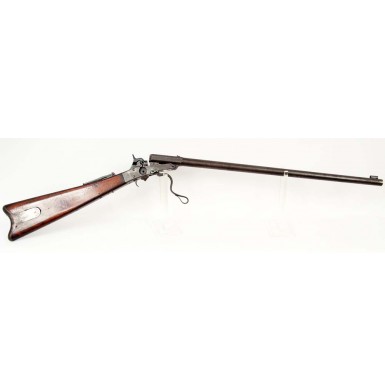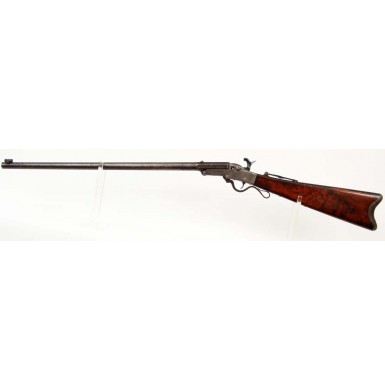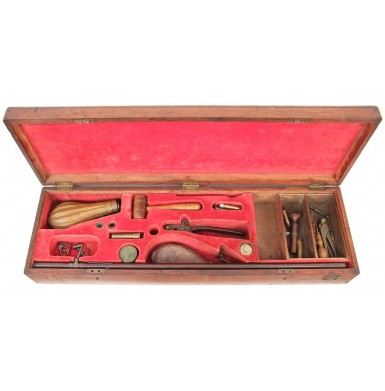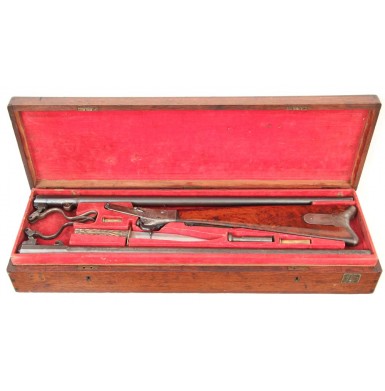Cased Sharpshooter's 1st Model Maynard in CS Purchase Range
- Product Code: FLA-2086-SOLD
- Availability: Out Of Stock
-
$1.00
This is a wonderful and possibly one of a kind example of very rare and desirable cased 1st Model Maynard rifle and shotgun combination, which was clearly custom ordered for long-range shooting and possibly military sharpshooting use. The 1st Model Maynard was the invention of famous dental surgeon and firearms innovator Dr. Edward Maynard. Dr. Maynard is probably best known for his invention of the Maynard Tape Priming System, an automated priming system that utilized a varnished strip of paper with small amounts of fulminate of mercury, similar to a modern day child’s cap gun. The system advanced the roll of primers each time the hammer was cocked, and upon firing, the hammer cut off the spent cap. This system showed such promise and was so well thought of by the US Ordnance Department that the US Government paid Maynard $75,000 for the use of his priming system on the US M-1855 series of arms. In addition to his tape-priming patent (#4,208, issued in 1845), Maynard received a total of 23 US patents related to innovations or improvements to firearms designs. Maynard’s carbine design was an innovative breech-loading firearm, which used a proprietary brass cartridge loaded with powder and a lubricated bullet and that utilized Maynard’s tape priming system for ignition. Maynard paid the Springfield Armory $116.37 in 1853 to produce a full scale model of his carbine, and this model was subsequently tested by the Ordnance Department in 1856 with very positive results. The successful trials resulted in the formation of the Massachusetts Arms Company in 1857, which was formed for the purpose of producing Dr. Maynard’s breech loading long arm. The guns were produced in both carbine and rifle lengths, with 20” and 26” barrels respectively, and were offered in both .35 and .50 caliber. The U.S. Army held additional trials of breech loading long arms in 1858, and the Maynard’s ease of operation and ability to function quickly and reliably helped to win the Massachusetts Arms Company a contract for 400 of their .50 military pattern carbines. These guns were ordered with fixed sights only (no tang sight), and specified the use of a sling ring on the trigger plate tang, rather than on a traditional sling bar on the side of the carbine. These carbines were delivered in March and April of 1859. In late 1859 the US Revenue Cutter Service ordered an additional 200 Maynard carbines. While the first 100 arms ordered were referred to as “rifles”, it is believed that all 200 of these guns were in fact carbines, chambered for the .50 Maynard cartridge. In February of 1860, the US Navy ordered 50 1st Model Maynard carbines, also in .50 caliber. While the Massachusetts Arms Company pursued what they perceived to be lucrative US government military contracts, they also produced sporting versions of the rifle and carbine and offered them for sale to the general public. The guns were available in both barrel lengths and calibers as well as in cased sets, often with a second barrel, loading tools and a variety of optional accessories. According to arms researcher, author and historian James D McAulay, a number of famous (and soon to be famous) Southerners purchased Maynard sporting arms. These men included South Carolina’s Wade Hampton, Georgia senator Robert Toombs and Vice President John Breckenridge of Kentucky; all of who became Confederate Generals during the American Civil War. The initial production goal of the Massachusetts Arms Company had been 5,000 arms. According to McAulay, as of October 1, 1860 the company had sold approximately 1,400 guns and had a total of 3,527 arms in inventory. The inventory on hand was distributed as follows:
326 2nd Quality Arms
459 .50 / 20” / Sporting
676 .50 / 20” / Military
142 .50 / 26” / Sporting
160 .50 / 26” / Military
1,326 .35 / 20” / Sporting
425 .35 / 20” Military
13 .35 / 26” / Military
McAulay further notes that approximately 90% of this remaining inventory of 1st Model Maynard rifles and carbines were purchased by southern states and militia companies between October 1, 1860 and April of 1861. McAulay’s research indicates that the majority of the guns went to the states of Mississippi, Florida and Georgia. According to his figures, Florida acquired a total of 1,030 guns in December of 1860, all of which were carbine length (20”) and were chambered in .35 caliber. Mississippi acquired 800 guns in December of 1860 as well. Their purchase included both carbines (625 total) and rifles (26” barrel, a total of 175) and the guns were a mixture of .50 and .35, with all 175 of the rifles and 300 of the carbines being .50 and the remaining 325 carbines being .35. All 650 of the Georgia purchased guns were all .50 caliber carbines. While Florida and Mississippi acquired their guns directly from the Massachusetts Arms Company, Georgia purchased their guns in January and March of 1861 from the firm of W.J. Syms & Brothers of New York City. Syms sold an additional 1,700 Maynards between October 1860 and May 1861. It is estimated that all but about 100 of these guns went to southern purchasers. McAulay notes that approximately 800 of these guns went South Carolina and Louisiana. The balance of the estimated 800 “Confederate” sales by Syms were apparently made to Kentucky and Tennessee in April and May of 1861. A substantial number of Confederate regiments were at least partially armed with 1st Model Maynard rifles and carbines during the Civil War, resulting in the guns (n both barrel lengths and calibers) being listed in the 1863 Confederate Ordnance Manual as a standard issue Confederate carbine. Some of the Confederate units armed with the guns included the 1st and 6th Florida Special Battalion of Infantry, 2nd Florida Cavalry, 5th & 9th Georgia Cavalry, Cobb’s Legion of Cavalry (Georgia), 1st Louisiana Cavalry, 11th Louisiana Infantry, 1st & 4th Mississippi Cavalry, 9th, 14th & 15th Mississippi Infantry, 18th North Carolina Infantry, 3rd Tennessee Cavalry, 35th Virginia Cavalry Battalion and the Waccamaw South Carolina Light Artillery. Some 1st Model Maynards were also issued to the Confederate ironclad CSS Atlanta. The production of the 1st Model Maynard was brought to an end by a fire at the Massachusetts Arms Company factory in January of 1861. It is not clear how many additional arms were produced between the October 1 inventory of 4,927 arms produced, but it is realistic to assume that based upon the spike in sales brought on by the prelude to Civil War, that Maynard kept the assembly lines running at maximum production levels, and it is likely that several hundred additional arms were produced prior to the fire two months later. After the conflagration, Dr. Maynard proceeded to buy out all of the various partners and owners of the company in 1862 and by 1863 the factory was back in business, producing the 2nd Model Maynard Carbine for the US Ordnance Department.
This Cased 1st Model Maynard Rifle & Shotgun Combination is a truly unique and extremely interesting casing. The group is clearly customized to be the ultimate 19th hunter’s outfit, although it is not clear if the intended game was of the four-legged or two-legged variety. Although 2 barrel 1st Model cased sets are encountered from time to time, this one has some very unique items in the casing. First of all the casing is a two-level set, which is very uncommon. Typical Maynard casings are only single level cased. The most interesting item included in the set is a wonderful 19th century telescopic sight. The sight is clearly engraved in two lines: F WASSMANN / WASHINGTON D.C.. Wassmann was a German immigrant from Hanover who was listed in the 1860 Census as a gunsmith in the Georgetown area of the District of Columbia. Wassmann apparently was a retailer as well, and probably sold this customized shooting set. The other unique item included in the casing is a clip point Bowie style knife. While the knife and scope are both items that would be of use to hunter, they would also be very useful to a military sharpshooter. There is an old name in pencil on the lower interior edge of the case lid. The name appears to read LONG and is followed by the number 47th and then a couple of letters that I cannot decipher. A search of Confederate regimental rosters for “47th” regiments revealed that Richard Long of Appling County, Georgia initially served in Company F of the 47th Georgia Infantry. However, on July 30, 1862 Long was transferred to the 1st Battalion of Georgia Sharpshooters, Company A. Long served with the sharpshooter until he was killed in action at Chickamauga on September 19, 1863. While the identification is tenuous, the fact that this unique sharpshooters shows significant use of the rifle and practically no use of the shotgun, suggests that the rifle may have seen military service in the field.
The double decker 1st Model Maynard Casing includes the following items:
On the upper level:
1st Model Maynard “Sporting Rifle” Frame, serial number 780.
A 26” long .35 caliber “Sporting Rifle” barrel, serial number 780.
A 26” long 24-gauge (about .58 caliber) shotgun barrel, graduated to what would be full-choke (about .54 caliber) with no serial number.
An English Bowie knife with a 6 ““ blade, 11” in overall length.
3 reloading tools.
The lower lever contains:
A 26” long telescopic sight.
The scope mounts for the scope.
A variety of fixed and adjustable front and rear sight inserts.
A large copper powder flask.
2 spouts for the flask (1 fixed & 1 adjustable).
1 leather shot flask.1 .35 caliber, single cavity Mass Arms bullet mold.
2 tins of percussion caps.
1 Pewter oiler.
A wooden hammer / reloading tool.
A variety of cleaning implements, additional reloading tools and assorted brass & cartridges.
The overall condition of the entire cased set is about VERY GOOD+ to NEAR FINE. The frame rates about FINE. As noted above, it is serial numbered 780, and the number is located inside the tape priming door. This number places the gun at the front end of the "Confederate purchase range". The frame has a smoky gray patina, with some light traces of the original mottled case coloring present. The frame is essentially smooth and free of any pitting, showing only some salt & pepper surface darkening. The hammer, trigger, take down pin, barrel lug screw and wedge adjustment screw all retain the majority of their original fire blued finish and are quite striking. The Maynard tape priming system is 100% complete and fully functional. The action of the gun functions crisply and correctly on all positions. The frame is clearly marked in two lines on the lower right side: MAYNARD ARMS CO. / WASHINGTON. It is additionally marked on the lower left side: MANUFACTURED BY / MASS. ARMS CO. / CHICOPEE FALLS and on the patchbox door: MAYNARD PATENTEE / SEP 22 1845 / MAY 27 1851 / JUNE 17 1856. The original long-range tang sight is in place on the top of the frame tang, and it also retains the majority of its original fire blued finish. Sight is complete and fully functional. The buttplate has a smooth medium gray-brown patina. The buttplate and frame screws are all relatively crisp with only minimal slot wear and all retain between 30% and about 70% of their fire-blued finish. The buttstock is made from a particularly attractive piece of burled walnut, which is furniture grade and absolutely gorgeous. The stock retains the majority of its original varnish, and is free of any breaks, cracks or repairs. The stock does show a number of small bumps and dings from service and use, but no abuse. The only real condition issue worth noting is a small amount of wood wear and loss at the front edge of the patchbox where the lid is pried open. Unfortunately, the original Maynard paper label is no present in the patchbox, but these labels are rarely found in the patchbox these days. The 26” long .35 rifle barrel is in about VERY GOOD condition. The barrel is serial numbered to the frame, with the number 780 located between the two barrel lugs. The bottom of the barrel is also marked with the expected Maynard M mark. The barrel has a mostly smooth, plum-brown patina, mixed with about 20% faded & thinned original blue. There are a few minor patches of very light surface oxidation but no notable pitting or roughness. The bore of the rifle rates about FINE and is mostly bright with excellent rifling. There is only some lightly scattered pitting in the grooves, and a few small patches of minor oxidation along the length of the bore. The barrel locks into the frame tightly and securely with no slop or wiggle. The top of the barrel has two dovetail cuts, which allow the insertion of the sight inserts and the scope mounts. Massmann probably cut the dovetail notches, not the Mass Arms factory, as the front dovetail is cut over the remains of the original front sight. The included sight inserts are a two-leaf version of the usual 1st Model Maynard fixed rear sight, and three front sight blades, including a hooded post front sight. The dovetails also accept a pair of mounts, which allow the attachment of the included 26” long telescopic sight. The sight is about 5/8” in diameter, and the front portion of the tube extends about ““ of an inch past the forward lens, serving as a rudimentary sunshade. The interior tube is draw adjustable for focus and the sight appears to be about 2x in magnification. The sight uses a simple crosshair reticle. The exterior tube retains about 60% of its original lacquer browned finish, which is thinning and starting to fade. The interior tube is blued and retains nearly all of its finish. The top of the sight tube also has a quick acquisition, “back up” iron rear sight, and the front scope mount includes a small blade on the top of the ring to serve as the emergency front sight. The shotgun barrel rates about VERY FINE+ condition. The barrel retains about 85% of its original blue, with some fading and minor wear, and the bore is in EXCELLENT condition. The bore is brilliant with a mirror polish. As is so often the case with a second barrel in a 2-barrel Maynard cased set, the shotgun barrel has no serial number, but does have the Maynard M between the lugs. The Bowie knife is of English origin and is probably not the original knife for the set, but a later replacement. The knife fits the recess very well, but is marked ENGLAND on the obverse ricasso, suggesting post-1891 importation into the United States. The reverse ricasso is marked E.M. DICKINSON / SHEFFIELD. A knife of the same style was no doubt originally included in this custom casing. The original, and well used .35 Mass Arms single cavity iron bullet mold is in place in the appropriate recess in the lower portion of the set. What appears to be the original copper powder flask is in the lower section as well, and it includes a pair of detachable spouts, one fixed and one adjustable. The flask is completely untouched and is fully functional with the original spring in place on top. A period leather shot flask is in the correct recess as well, but I do not know if it is original to the set. What appears to be the original pewter oiler is present in its recess as well. A number of period Maynard accessories are present in the cased set, including a variety of loading and cleaning tools, 3 loaded and 2 empty .35 cartridges, and a single piece of 24-gauge brass. The two-level custom casing is in about VERY GOOD condition. It is a lovely dovetailed case that appears to have been made from solid walnut. The case retains much of its original varnish and is very attractive. The case has a red baize lining that shows significant wear. The case is in solid condition and is clearly original to the gun.
Overall this is a really fantastic example of a customized and cased Maynard 1st Model Rifle. To my knowledge, this is the only cased 1st Model Maynard known that includes a telescopic sight. This wonderful rifle is worthy of significant research to determine if the tentative identification is in fact correct and provable. If so, the value of this set is dramatically higher than the price it is being offered for. Any item related to Civil War sharpshooters is extremely rare and valuable, but an identified Confederate sharpshooters rifle would be nearly priceless. Even without substantiating the identification, this is a wonderful, one of a kind Civil War era Maynard casing that would be a wonderful centerpiece to any Civil War era arms display.
Due to size, weight and value, additional shipping costs will apply.
SOLDTags: Cased, Sharpshooters, 1st, Model, Maynard, in, CS, Purchase, Range,




















